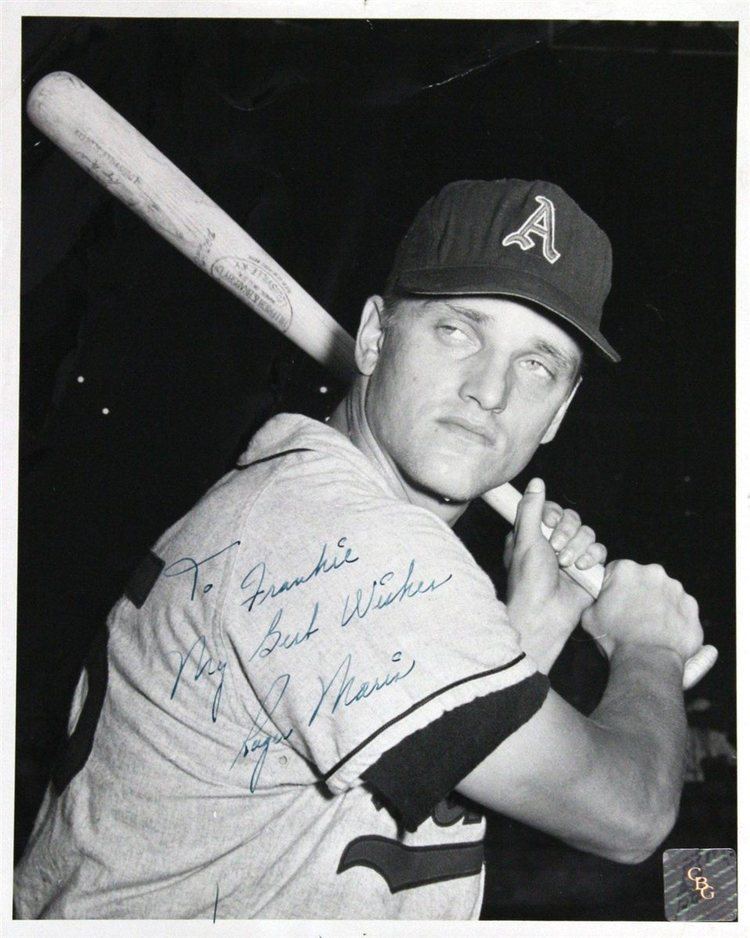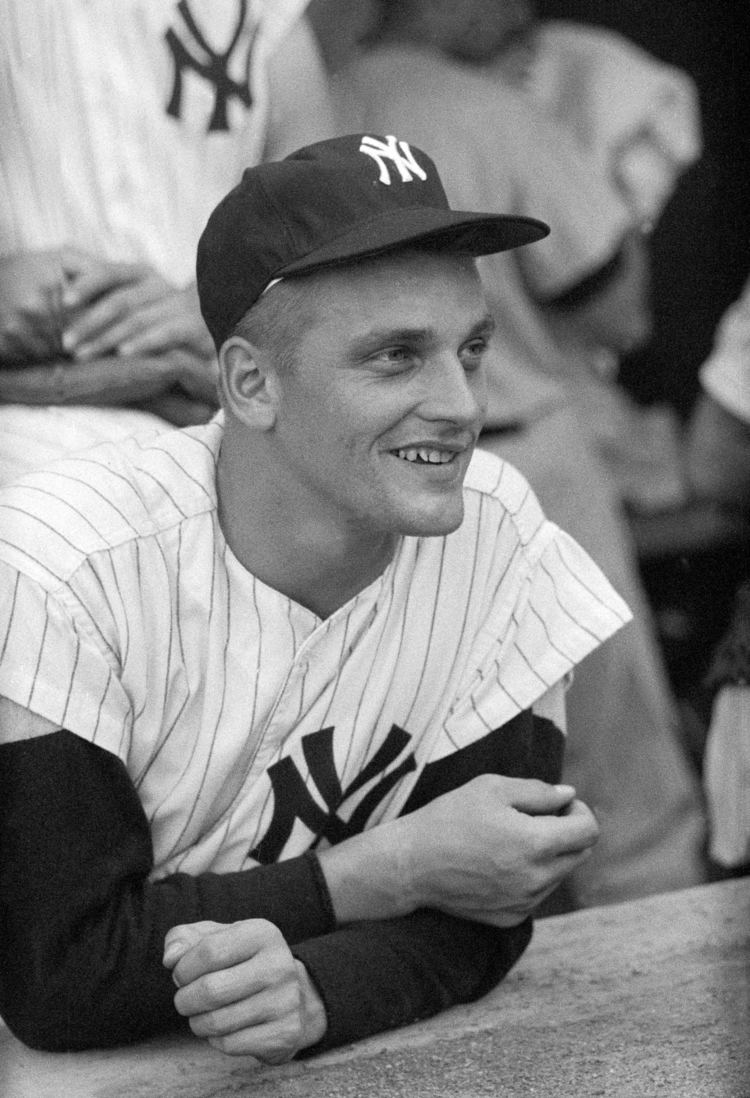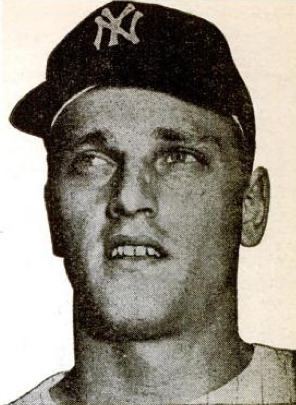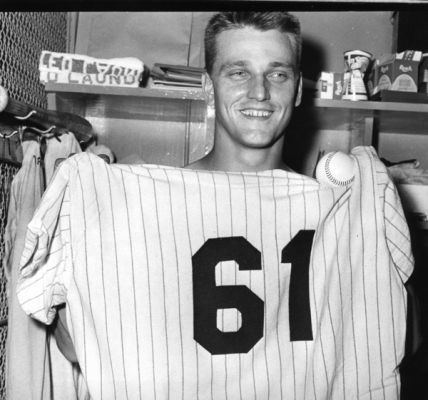Batting average .260 Role Baseball player Home runs 275 Height 1.82 m | Runs batted in 850 Movies That Touch of Mink Name Roger Maris | |
 | ||
Spouse Patricia A. Maris (m. 1956–1985) Similar People | ||
Roger maris baseball s greatest unsung hero
Roger Eugene Maris (September 10, 1934 – December 14, 1985) was an American professional baseball player who played four seasons in the minor leagues and twelve seasons in the major leagues. Maris played right field on four Major League Baseball (MLB) teams, from 1957 through 1968.
Contents
- Roger maris baseball s greatest unsung hero
- Yankeeography roger maris
- Early years
- Minor league
- Cleveland Indians 195758
- Kansas City Athletics 195859
- New York Yankees 1960 66
- St Louis Cardinals 196768
- Later years and death
- Stats
- References

Maris set the MLB record for home runs during the 1961 season with 61*, breaking Babe Ruth's single-season record of 60 home runs in 1927. This record was challenged by then-baseball commissioner Ford Frick (who had been a friend of Babe Ruth), who said that Maris needed to break the record in 154 games instead of the current schedule of 162 games. His accomplishment of 61 home runs in a season came back to the forefront in 1998, when the home run record was broken by Mark McGwire and later that same year by Sammy Sosa.

Maris began playing in the minor leagues in 1953. He reached the major leagues in 1957 playing for the Cleveland Indians. He was traded to the Kansas City Athletics during the 1958 season, and to the New York Yankees after the 1959 season. He finished his MLB career playing for the St. Louis Cardinals in 1967 and 1968. Maris was an American League (AL) All-Star from 1959 through 1962, an AL Most Valuable Player in 1960 and 1961, and an AL Gold Glove Award winner in 1960. Maris appeared in seven World Series, five as a member of the Yankees and two with the Cardinals.

Yankeeography roger maris
Early years

Roger Eugene Maras was born on September 10, 1934 in Hibbing, Minnesota, later changing his surname to Maris. Maris' parents, Rudolph S. "Rudy" Maras and Corrine (née Perkovich), were both of Croatian origin. Roger had a brother, Rudy (known as "Buddy") who was a year older. Rudy developed polio in 1951.
The Maras family moved to Grand Forks, North Dakota in 1942 and to Fargo, North Dakota in 1946, where he attended Fargo Central High School. Maris' parents had a turbulent marriage and divorced in 1960. His father died in Fargo in 1992 at age 81. After Maris retired from baseball he moved to Gainesville, Florida, where his mother moved to from Fargo. Corrine Maras died in 2004 at the age of 90.
Maris transferred to Shanley High School at Fargo in 1950, and graduated from there in June 1952. He met his future wife, Patricia, in the tenth grade, while both were attending a high school basketball game. Roger and Rudy Maris Jr. both participated in sports including American Legion baseball during the summers while in Fargo. In 1950, Roger led his North Dakota legion team to the state championship. He was a standout player with the Fargo-Moorhead Twins of the Northern League in 1952. In football, Roger still holds the official high school record for most return touchdowns in a game, with four (two kickoff returns, one punt return, and one interception return).
Maris was recruited to play football at the University of Oklahoma. He decided to go there, but after visiting the campus, he returned to Fargo where he wanted to stay the most and be near his brother who was sick with polio. He decided finally on a baseball career. In 1953, he was invited to the Cleveland Indians tryout camp where he was viewed by the Cleveland Indians general manager, Hank Greenberg (he hit 58 home runs for the Detroit Tigers in 1938). Greenberg afterwards sent a representative to Fargo to sign Maris. Maris, age 18, then signed a contract for $15,000 with the Cleveland Indians of the American League which included a $10,000 bonus from them if he made it to the major leagues.
Minor league
Maris started playing for the Indians minor league organization at Fargo (Fargo-Moorhead Twins) in 1953 (after being sent to and beginning spring training in Daytona, Florida) where he was named rookie of the year in the Fargo-Moorhead Twin's Northern League, and moved to Keokuk, Iowa the next season. In the minor leagues, he showed a talent for both offense and defense. He tied for the Illinois–Indiana–Iowa League lead in putouts by an outfielder with 305 while playing for the Keokuk Kernels in 1954. Meanwhile, in four minor league seasons from 1953 to 1956, Maris hit .303 with 78 home runs. In Game 2 of the 1956 Junior World Series, Maris would set a record by getting seven runs batted in. With the five teams that Maris played for in the minors, the clubs' won loss records would improve from the previous season – a clear indication of Maris' talent and value.
Cleveland Indians (1957–58)
Maris made his major league debut on April 16, 1957 with the Cleveland Indians. Two days later, he hit the first home run of his career, a grand slam off Tigers pitcher Jack Crimian at Briggs Stadium in Detroit. He finished his rookie season with 14 home runs. In 1958, after playing in 51 games and hitting 9 home runs, he was traded to the Kansas City Athletics.
Kansas City Athletics (1958–59)
Maris was traded to the Kansas City Athletics with Dick Tomanek and Preston Ward for Vic Power and Woodie Held. He played in 99 games and hit 19 home runs. In 1959, he hit 16 home runs and represented the A's in the 1959 All-Star Game (played in second game) in spite of missing 45 games due to an appendix operation.
In the late 1950s, Kansas City frequently traded their best young players to the New York Yankees – a practice which led them to be referred to as the Yankees' "major league farm team" – and Maris was no exception. In a seven-player deal in December 1959, he was sent to the Yankees with Kent Hadley and Joe DeMaestri in exchange for Marv Throneberry, Norm Siebern, Hank Bauer, and Don Larsen.
New York Yankees (1960-66)
Maris hit a single, double, and two home runs in his first game as a Yankee outfielder in 1960. In his first season with the Yankees, he led the American League in slugging percentage, runs batted in, and extra base hits. He hit 39 home runs, one home run behind teammate Mickey Mantle. He won the American League's Most Valuable Player award and was recognized as an outstanding defensive outfielder with a Gold Glove Award. He was named to the American League All-Star roster (played in two games) and finished the 1960 season with a .283 batting average. The Yankees won the American League pennant, the first of five consecutive pennants, but lost a seven-game World Series to the Pittsburgh Pirates culminating in Bill Mazeroski's dramatic walk-off home run.
In 1961, The American League expanded from 8 to 10 teams. In the expansion draft, the newly created Los Angeles Angels and Washington Senators were restricted to drafting players from AL rosters. The perceived result was that American League team rosters had become watered down as players who would otherwise have been playing at AAA if not lower were now in the AL. The Yankees, however, were left mainly intact. In order to maintain a balanced schedule, AL owners extended the season from 154 games to 162 games. On January 23, 1961, an Associated Press reporter asked Maris whether the schedule changes might threaten Babe Ruth's single-season home run record; Maris replied, "Nobody will touch it... Look up the records and you'll see that it's a rare year when anybody hits 50 homers, let alone 60."
Yankee home runs began to come at a record pace. One famous photograph lined up six 1961 Yankees, including Mantle, Maris, Yogi Berra, and Bill Skowron, under the nickname "Murderers Row", because they hit a combined 165 home runs the previous season (The title "Murderers Row", originally coined in 1918, had most famously been used to refer to the 1927 Yankees). As mid-season approached, it seemed quite possible that either Maris or Mantle, or perhaps both, would break Ruth's 34-year-old home run record. Unlike the home run race of 1998, where both Mark McGwire and Sammy Sosa were given extensive positive media coverage in their pursuit of Maris' record, sportswriters in 1961 began to play the "M&M Boys" against each other, inventing a rivalry where none existed, as Yogi Berra has told multiple interviewers.
Five years earlier, in 1956, the New York press had been protective of Ruth when Mantle challenged Ruth's record for most of the season. When Mantle fell short, finishing with 52, there seemed to be a collective sigh of relief from the New York traditionalists. The New York press had not been kind to Mantle in his early years with the team; he struck out frequently, was injury prone, was a true "hick" from Oklahoma, and was perceived as being distinctly inferior to his predecessor in center field, Joe DiMaggio. Mantle, however, over the course of time (with a little help from his friend and teammate Whitey Ford, a native of New York's Borough of Queens), had gotten better at "schmoozing" with the New York media, and consequently gained the favor of the press. This was a talent that Maris, a blunt-spoken Upper Midwesterner, never attempted to cultivate. Maris was perceived as surly during his time on the Yankees.
More and more, the Yankees became "Mickey Mantle's team" and Maris was ostracized as an "outsider" and "not a true Yankee." The press at that time seemed to be rooting for Mantle and belittling Maris. Mantle, however, was felled by a hip infection causing hospitalization late in the season, leaving Maris as the single remaining player with the opportunity to break Ruth's home run record.
On top of his lack of popular press coverage, Maris' chase for 61 homers hit another roadblock totally out of his control: along with adding two teams to the league, Major League Baseball had added eight more games to the schedule. In the middle of the season, baseball commissioner Ford Frick (one of Babe Ruth's closest friends) announced that unless Ruth's record was broken in the first 154 games of the season, the new record would be shown in the record books as having been set in 162 games while the previous record set in 154 games would also be shown. It is an urban legend that an asterisk (*) would be used to distinguish the new record, sparked by a question given to Commissioner Frick from New York sportswriter Dick Young.
Nash and Zullo argued in The Baseball Hall of Shame that Frick made the ruling because the former newspaper reporter had been a close friend of Ruth's. Furthermore, Hall of Famer Rogers Hornsby – himself a lifetime .358 batter – compared Ruth's 1927 batting average of .356 to Maris' .269 clip of 1961 and said, "It would be a disappointment if Ruth's home run record were bested by a .270 hitter". (Hornsby, however, was not easy to impress; while scouting for the Mets, the best report he could muster for any current player was "Looks like a major-leaguer." The assessment referred to Mickey Mantle.) Maris downplayed the challenge, saying, "I'm not trying to be Babe Ruth; I'm trying to hit sixty-one home runs and be Roger Maris." This sentiment would be echoed in 1973–1974, when Hank Aaron, in pursuit of Ruth's career home run record, said, "I don't want people to forget Babe Ruth. I just want them to remember Henry Aaron."
Maris had 59 home runs after the Yankees' 154th game and failed to beat Ruth's 60 home runs within the original season length. Maris hit his 61st home run on October 1, 1961, in the fourth inning of the last game of the season, at Yankee Stadium in front of 23,154 fans. Boston Red Sox pitcher Tracy Stallard gave up the record home run, which was caught by fan Sal Durante in the right field bleachers. No asterisk was subsequently used in any record books; Major League Baseball itself then had no official record book, and Frick later acknowledged that there never was official qualification of Maris' accomplishment. The Guinness Book of World Records did however differentiate the two records as distinct and separate for a number of years. However, Maris remained bitter about the experience. Speaking at the 1980 All-Star Game, Maris said, "They acted as though I was doing something wrong, poisoning the record books or something. Do you know what I have to show for 61 home runs? Nothing. Exactly nothing." Despite all the controversy and criticism, Maris was awarded the 1961 Hickok Belt as the top professional athlete of the year, and won the American League's MVP Award for the second straight year. It is said, however, that the stress of pursuing the record was so great for Maris that his hair occasionally fell out in clumps during the season. Later, Maris even surmised that it might have been better all along had he not broken the record or even threatened it at all.
In 1962, Maris made his fourth consecutive All-Star team appearance and his seventh and final All-Star game appearance (1959–62, two All-Star games were played per season). His fine defensive skills were often overlooked. He made a game-saving play in the bottom of the ninth inning of Game 7 of the 1962 World Series against the San Francisco Giants. With the Yankees leading 1-0 and Matty Alou on first, Willie Mays doubled toward the right-field line. Maris cut off the ball and made a strong throw to prevent Alou from scoring the tying run; the play set up Willie McCovey's series-ending line drive to second baseman Bobby Richardson, capping what would prove to be the final World Series victory for the "old" Yankees.
In 1963, he played in only 90 games, hitting 23 home runs. Maris was again injured in Game Two of the 1963 World Series after only five home plate appearances.
In 1964, he rebounded, appearing in 141 games, batting .281 with 26 home runs. Maris hit a home run in Game 6 of the 1964 World Series. But in 1965, his physical problems returned, and he had off-season surgery to remove a bone chip in his hand. In 1966, the Yankees' and Maris' fortunes continued to decline as he played most of the season with a misdiagnosed broken bone in his hand. The oft-injured Maris was questioned by the organization, media and fans. He was traded on December 8, 1966 to the St. Louis Cardinals.
St. Louis Cardinals (1967–68)
Maris was traded by the Yankees to the St. Louis Cardinals for Charley Smith. Maris played his final two seasons with the Cardinals, helping to win the 1967 and 1968 pennants. He was outstanding in the 1967 World Series, hitting .385 with one home run and seven RBIs. It was the best performance of his seven career World Series. Maris hit his 275th and final regular season home run on September 5, 1968. It was his 25th career two-run homer.
Later years and death
Maris and his brother owned and operated Maris Distributing in the 1970s and 80s, the Budweiser beer distributorship in Gainesville, Florida (and Ocala, Florida), where he moved after retiring from baseball after the 1968 season. Gussie Busch, who owned both the Cardinals and Anheuser-Busch, got Maris started into the beer business. Maris also coached baseball at Gainesville's Oak Hall High School, which named its baseball field after him in 1990.
Maris was diagnosed with Non-Hodgkin lymphoma in 1983. In response, Maris organized the annual Roger Maris Celebrity Golf Tournament to raise money for cancer research and treatment.
Maris died at age 51 on December 14, 1985 at M.D. Anderson Hospital in Houston, Texas. A Roman Catholic, he was buried at Holy Cross Cemetery in Fargo, North Dakota. Fellow major league player Ken Hunt was interred several feet away from Maris in 1997.
